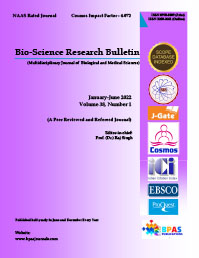Integrated Management for Post-Harvest Diseases of Fruits and Vegetables
DOI:
https://doi.org/10.48165/Keywords:
Fruits, Vegetables, Post-harvest, Pathogen, Diseases, BiologicalAbstract
The post-harvest diseases known as the diseases which developed during harvesting of part of the plants like fruits, vegetables and seeds. Due to high moisture content and nutrient in harvested fruits and vegetables they are vulnerable to attack by pathogenic organism. Injuries of fruits and vegetables maybe caused during harvesting, packing, transposition, storage and after consumer purchase. They help in pathogen to enter the host and cause damage. The plant parts may get infected in field, but expression of symptom may take place later, at any stage before final consumption. The post-harvest disease that causes spoilage of both durable and perishable commodities is wide spread. The capability of a microorganism to initiate post-harvest diseases, as well as its final outcome, depend on number of factors that can conveniently be associated with, microorganism, host and the environment. This study discussed the physical, chemical and biological integrated methods for the control of post-harvest diseases.
References
Abdel-Kader AS, Morris LL, and Maxie EC. (1968) Physiological studies of gamma-radiated tomato fruits. II. Effect on deterioration and shelf-life. Proc. Am. Soc. 93: 831-842.
Agrios, G. (2005) Plant Pathology. 5th Edition, Elsevier Academic Press, Amsterdam, 26-27: 398-401.
Beno-Moualem, D., andPrusky, D. (2000) Early events during quiescent infection development by Colletotrichum gloeosporioides in unripe avocado
fruits. Phytopathology, 90(5): 553-559. 4. Blum, L.E.B., Amarante, C.V.T., Valdebenito-Sanhueza, R.M., Guimaraes, L.S., Dezanet, A., and Hack-Neto, P., (2004) Postharvest application of Cryptococcus laurentii reduces apple fruit rots. Fitopatol. Brasi., 29(4): 433–436.
Conway WS, Sams C.E, Wang CY, and Abbott J.A. (1994) Additive effects of postharvest calcium and heat treatment on reducing decay and maintaining quality in apples. J Am Soc Hort Sci. 119: 49–53.
El Ghaouth, A., Arul, J., Asselin, A., and Benhamou, N. (1992) Antifungal activity of chitosan on post-harvest pathogens: induction of morphological and cytological alterations in Rhizopus stolonifer. Mycological research, 96(9): 769- 779.
Klein JD. and Lurie S. (1991) Postharvest heat treatment and fruit quality. Postharvest News and Information 2(1): 15–19.
Kolesnik, A., and Bruev, S. (1983) Low Temperature Storage of Fruits and Vegetables. Izvestiya Vysshikh Uchebnykh Zavedenii Pishchevaya Tekhnologiya, (3): 68- 71.
Kore, V.T., and Chakraborty, I. (2014) A review of non-chemical alternatives to SO2 fumigation to prevent pericarp browning of litchi. International Journal of Fruit Science, 14(2): 205-224.
Korsten L, De Villiers EE, and Lonsdale JH. (1993) Biological control of mango postharvest diseases in the packhouse. South African Mango Grower’ Association Yearbook 13:117-121.
McLaughlin, R.J., Wilson, C.L., Chalutz, E., Kurtzman, W.F. and Osman, S.F.,(1990) Characterization and reclassification of yeasts used for biological control of postharvest diseases of fruit and vegetables. Appl. Environ. Microbiol., 56: 3583–3586.
Nooden, L. D. (Ed.). (2012) Senescence and aging in plants. Elsevier.
Pandey, B. K., Singh, U. S., and Chaube, H. S. (1987) Mode of infection of Ascochyta blight of chickpea caused by Ascochyta rabiei. Journal of Phytopathology, 119(1): 88- 93.
Pusey, P.L. and Wilson, C.L.,(1984) Postharvest biological control of stone fruit brown rot by Bacillus subtilis. Plant Dis., 68: 753– 756.
Salunkhe, D.K. (1961) Gamma radiation effects on fruits and vegetables. Econ. Bot. 15: 28-56.
Singh, Z. (2013) Lost fresh horticultural produce and maintenance of quality in supply Chain: Tropical and sub-tropical fruit. In II Southeast Asia Symposium on Quality Management in Postharvest Systems, 1088:29-39.
Smith, W.L. Jr. and Worthington, J.T., (1965) Reduction of postharvest decay of strawberries with chemical and treatments. Plant Dis. Reptr., 49: 619–623.
Sumbali, G., R.S. Mehrotra and M.U. Charaya (2001) Post-harvest Diseases of Vegetables and Their Management, in: Diseases of Fruits and Vegetables and Their Management, T.S. Thind (Ed.), Kalyani Publisher, Ludhiana, pp.422-438.
Tian, S.P., Fan, Q., Xu, Y., Qin, G.Z. and Liu, H.B., (2002) Effect of biocontrol antagonists applied in combination with calcium on the control of postharvest diseases in different fruit. Bulletin OILB/SROP, 25(10): 193–196.
Tripathi, A., Sharma, N., Sharma, V. and Alam, A. (2013) A review on conventional and non-conventional methods to manage post-harvest diseases of perishables. Researcher, 5(6): 6-19.
Utkhede, R.S., and Sholberg, P.L., (1986) In vitro inhibition of plant pathogens: Bacillus subtilis and Enterobacter aerogenes in vivo control of two postharvest cherry diseases. Canadian J. Microbiol., 32: 963–967.
Weber, R.W. and Hahn, M. (2019) Grey mould disease of strawberry in northern Germany: causal agents, fungicide resistance and management strategies. Applied microbiology and biotechnology, 103(4): 1589-1597.
Wilson C.L, and Wisniewski M. (1994) Biological control of postharvest diseases
theory and practice. CRC Press. Boca Raton 182 pp.
Zhang, H., Zheng, X.D. and Yu, T., (2007) Biological control of postharvest diseases of peach with Cryptococcus laurentii. Food Control, 18(4): 287–291.
